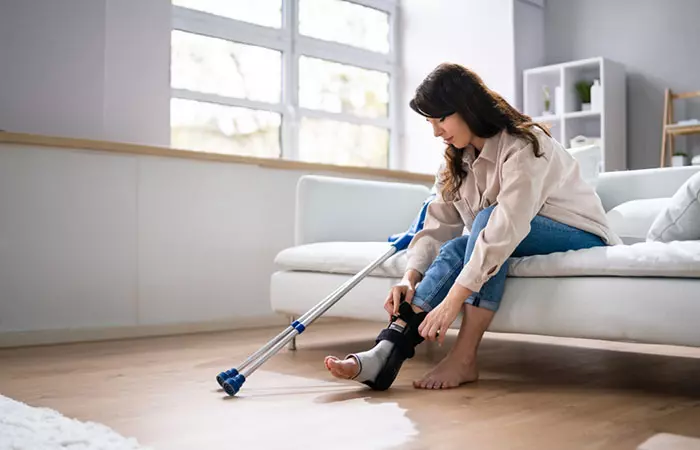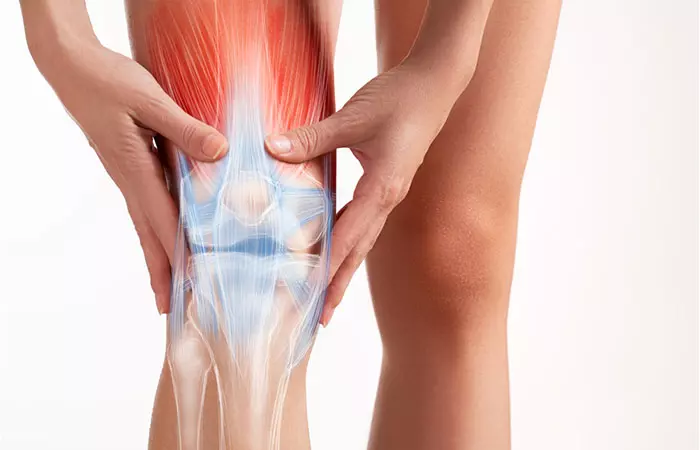7 Reasons Why One Of Your Legs Can Become Shorter In The Long Run

Image: Shutterstock
Leg length discrepancy, or a noticeable difference in the length of your legs, can be a distressing condition that affects your posture, gait, and overall well-being (1). While most people have a slight leg length difference that goes unnoticed, significant differences can lead to various health complications. In this article, we will explore seven reasons why one of your legs may become shorter with time and how it can impact your daily life. Read on to learn more about it.
In This Article
1. Developmental Differences
One of the most common causes of leg length discrepancy is developmental differences during childhood and adolescence. In some cases, unequal growth rates of the long bones, such as the femur or tibia, can occur (2). These variations can arise from genetic factors or conditions like scoliosis, which affects the alignment of the spine (3). If left untreated, these differences can persist into adulthood. Leg length discrepancies caused by developmental differences may range from a few millimeters to several centimeters. While minor discrepancies often go unnoticed, significant differences can lead to issues with posture, joint pain, and an altered gait pattern (4).
2. Injury Or Trauma
An injury or trauma to the leg, hip, or knee can also result in leg length discrepancy (5). Fractures, dislocations, or damage to growth plates during skeletal development can interfere with proper bone growth (6). Surgical interventions to address these injuries may sometimes lead to leg length discrepancies as well, particularly if the healing process is not ideal (7). When a bone is broken, it may heal in a shortened or lengthened position, resulting in a noticeable difference in leg length. Additionally, growth plate injuries in children and adolescents can disturb bone growth, leading to a significant leg length discrepancy. Early diagnosis, appropriate medical care, and rehabilitation can help minimize the impact of these injuries on leg length.
3. Bone Conditions And Diseases
Certain bone conditions and diseases can also contribute to leg length discrepancy. For instance, conditions like osteomyelitis (bone infection) or osteochondroma (a benign bone tumor) can disrupt normal bone growth, leading to an imbalance in leg length (8). Additionally, genetic conditions such as achondroplasia (a form of dwarfism) can cause disproportionate bone growth and result in leg length differences (9). Individuals with bone conditions may experience leg length discrepancies due to altered bone growth patterns.
4. Muscular Imbalances
The muscles surrounding the hips, pelvis, and lower back play a vital role in maintaining proper leg alignment and balance (10). Weakness or tightness in these muscles can cause one leg to appear shorter. Conditions like muscular dystrophy or cerebral palsy, which affect muscle tone and function, can exacerbate this issue (11). Muscular imbalances can affect leg length perception, even if the actual length of the bones remains unchanged. Tightness in certain muscles can cause tilting or rotation of the pelvis, leading to apparent leg length differences (12). Physical therapy, stretching exercises, and muscle-strengthening techniques can help alleviate muscle imbalances and improve overall leg alignment.
5. Joint Disorders
Conditions such as hip dysplasia or arthritis can lead to changes in joint structure and function, resulting in one leg becoming shorter (13). Over time, the progressive nature of joint disorders can further contribute to leg length discrepancies. Joint disorders can cause wear and tear of the joint surfaces, leading to changes in the joint’s shape and alignment. This can result in a leg length discrepancy due to the altered positioning of the joint. Managing joint disorders through appropriate medical interventions, physical therapy, and lifestyle modifications can help minimize leg length differences and improve overall joint health.
6. Postural Abnormalities
Postural abnormalities can affect leg length. Poor posture, such as consistently standing with uneven weight distribution or favoring one side of the body, can cause muscles to adapt and shorten, leading to apparent leg length differences (14). Correcting postural habits and maintaining proper alignment can help mitigate this issue. Sustained poor posture can create imbalances in the muscles and soft tissues surrounding the spine and pelvis, leading to leg length discrepancies. These discrepancies are often functional in nature, meaning that they can be corrected by addressing the underlying postural habits and improving muscular imbalances. Physical therapy, postural exercises, and ergonomic adjustments can assist in restoring proper alignment and reducing leg length differences caused by poor posture.
7. Surgical Interventions
Surgeries involving the lower extremities, particularly joint replacements or procedures to correct deformities, can sometimes result in leg length discrepancies (15). Despite advancements in surgical techniques, achieving perfect limb length equality can be challenging. Surgeons carefully evaluate the risks and benefits of maintaining leg length parity versus addressing the underlying condition during such procedures.
Leg length discrepancy can arise from a variety of causes. If you suspect a leg length discrepancy, it is essential to consult with a medical professional who can assess your condition and recommend appropriate interventions. Treatment options may include physical therapy, orthotic devices, shoe modifications, or, in severe cases, surgical interventions. Remember, early detection and intervention can help alleviate symptoms and improve overall functionality, allowing you to lead an active and fulfilling life. So, which of these reasons of leg length discrepancy were you familiar with? Let us know in the comments section!






























